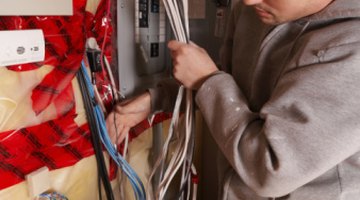How to Bend Conduit Into a Circle
Running conduit can be a frustrating job for the first-timer. Certain bends and angles need to be made so that the conduit and wiring can fit through narrow spaces. Depending on the size of your circle as well as the thickness of the conduit, you may experience a significant spring-effect once the circle is formed.

Things You Will Need
- Tape measure
- Calculator
- Conduit
- Conduit hand bender
Forming conduit into a circle is basically the same as making one big concentric bend, which is accomplished by making several smaller bends continuously in a conduit pipe, rather than making one large bend.
-
Plan out your circle by using a tape measure to gauge to the diameter of the circle, which is the entire width of the circle. Calculate the circumference of the circle by multiplying the diameter by 3.14 (pi).
-
Measure the length of the conduit to equal the circumference of the circle. Cut the conduit with a handsaw, making sure the saw is held at a 90 degree angle to the conduit.
-
Mark the conduit into equal lengths of either using a pen or marker. The spacing of your conduit lengths will depend on the overall length of the conduit. The longer and thinner the conduit, the less chance you will have of spring back affecting the finished product of your conduit circle. Spring back occurs when the conduit is pulled out of the bender and, depending on the conduit size and the size of the bend, springs back into its original shape. For shorter conduit lengths, divide the conduit into 20 sections, each of which will have 20 degree bend. Larger circumferences can be divided into 40 equal sections, which will have 10-degree bends. The extra 40 degrees will account for spring back for each of your circles.
-
Pull the conduit through the hand bender and bend each length on the marks made in the previous step. Although it is impossible to achieve a perfect circle, using the hand bender will curve each section into a 10 or 20 degree bend, which will add up to the necessary 360 degrees. Roll the hand bender, using pressure on the foot pedal while watching the angle sizer on the bending wheel. Use the handle of the bender as a guide for determining the correct angle rather than the main fulcrum at which pressure is applied to the conduit.
-
Use duct or electrical tape to tape the two ends of the conduit together once the circle is formed. This will eliminate some of the spring back. Re-measure the diameter of the conduit circle to make sure that it matches the measurement of the structure in which you are inserting the conduit.
Tip
If you are using the conduit for electrical purposes, insert the wiring into the conduit sleeve before bending it into a circle. If you use a pipe cutter to cut your conduit, be sure to use a reamer and file to remove sharp edges and burrs. Alternatively, if you do not have a specific diameter to which you must match your conduit circle, you can use a large circular object, such as an barrel or wheel rim to form your conduit circle.
References
- Albany Technical College: Bending Conduit/ Tubing Using Hand Benders: Billy Bamford: 2007
- Klein Tools: Conduit Bending Basics: 2010
- Cliffhanger Tools: Repeatable Conduit Bending: Cliff Howard
- ECM Web: The Basics of Bending Conduit — Part 1: Mark Lamendola: 1999
- ECM Web: The Basics of Bending Conduit — Part 2: Mark Lamendola: 1999
Resources
Writer Bio
David McGuffin is a writer from Asheville, N.C. and began writing professionally in 2009. He has Bachelor of Arts degrees from the University of North Carolina, Asheville and Montreat College in history and music, and a Bachelor of Science in outdoor education. McGuffin is recognized as an Undergraduate Research Scholar for publishing original research on postmodern music theory and analysis.
Photo Credits
- Jupiterimages/Photos.com/Getty Images
- Jupiterimages/Photos.com/Getty Images
More Articles



